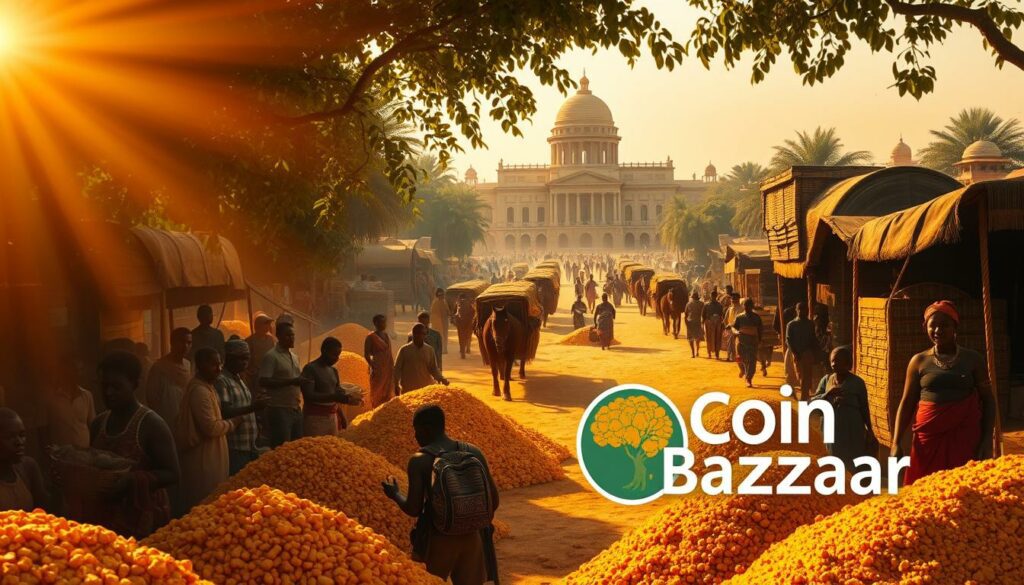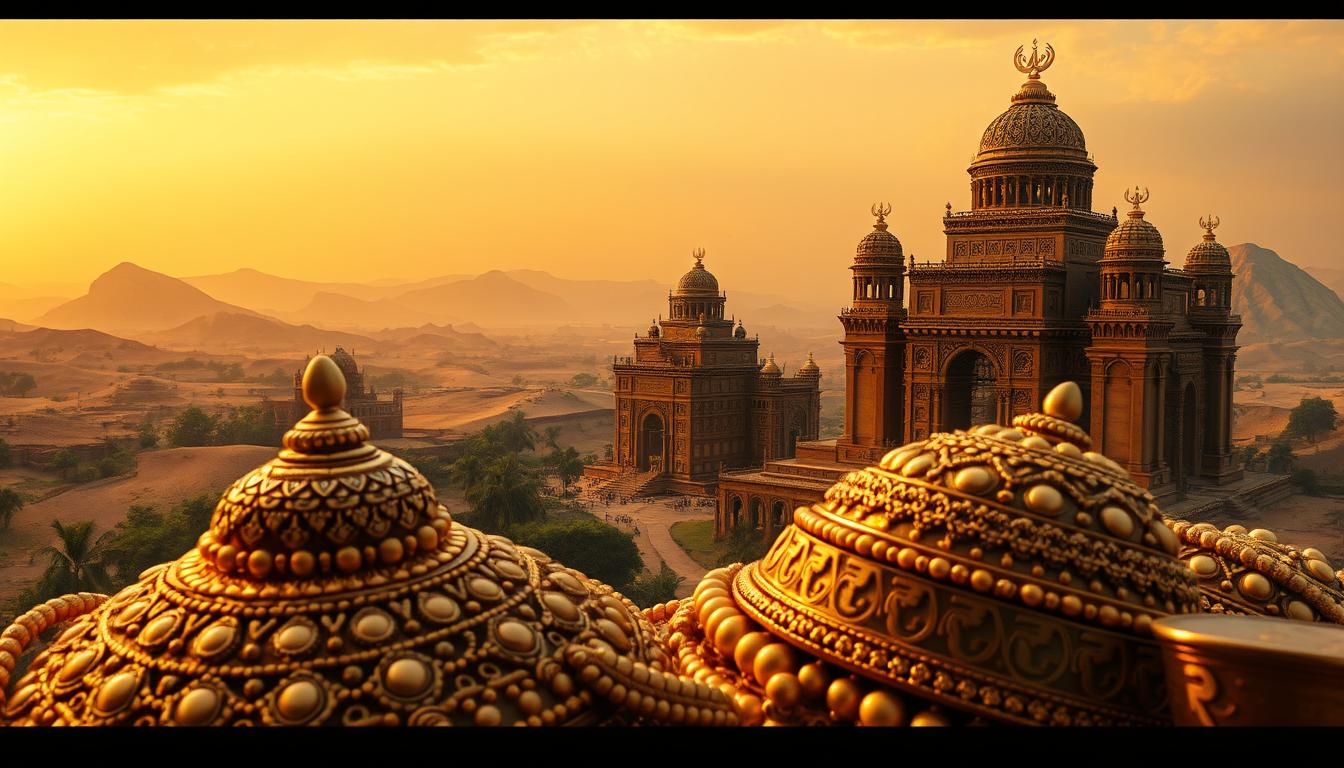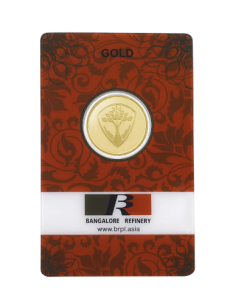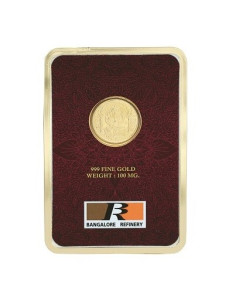Exclusive Deals & Trending Items


Kundan Lakshmi Gold Bar Of 2 Grams + Kundan Logo Gold Coin Of 0.5 Grams 24 Karat in 999.9 Purity COMBO SET
Shop NowGet ready to explore the fascinating history of African gold. This treasure has been sought after for centuries. It shows the rich history and cultural variety of the continent.
Gold has been key in Africa’s story, from the ancient kingdoms to today’s retail industry. As we look at African gold’s journey, you’ll see how it has shaped the continent.
Key Takeaways
- The historical significance of African gold in ancient kingdoms.
- The impact of gold on Africa’s cultural diversity.
- The role of the retail industry in modern trade practices.
- The evolution of African gold and its influence on the continent.
- The cultural and economic importance of gold in Africa.
The Golden Legacy of Africa
The story of African gold is as old as civilization itself. Africa has been key in shaping the global gold trade. You might be surprised to learn that West Africa was a top gold producer in the Middle Ages.
The trade in gold started long ago. But it really grew with the camel caravans of the Sahara. These caravans connected North Africa to the savannah interior. This history is key to understanding Africa’s Position in Global Gold Production.
Africa’s Position in Global Gold Production
Africa has been a big player in global gold production for centuries. The continent’s gold output has been shaped by many factors. These include historical trade routes and modern distribution channels.
Key Statistics and Historical Output
Some key statistics show Africa’s role in global gold production:
- Africa is home to several major gold-producing countries.
- The continent’s gold production has been steadily increasing over the years.
- Historical trade routes, such as the Trans-Saharan trade, played a significant role in Africa’s gold output.


Understanding these factors is crucial. It helps us see the complexities of the modern gold trade. As you explore African gold, you’ll find the complex networks of consumer goods and distribution channels that have evolved over time.
Ancient Gold Kingdoms of Africa
Exploring African gold history reveals the impact of ancient kingdoms. These kingdoms controlled vast trade networks and built significant wealth.


The Ghana Empire: West Africa’s First Gold Empire
The Ghana Empire thrived from the 8th to the 13th centuries CE. It was a key player in West Africa’s gold trade. Its control over trans-Saharan trade routes helped it amass vast riches.
The empire’s strategic location made it a dominant force in the gold trade. It became one of the wealthiest and most powerful empires of its time.
“The Ghana Empire’s control over the gold trade was a significant factor in its rise to power, enabling it to establish a complex system of trade and commerce that stretched across the Sahara Desert.”
Trade Systems and Wealth Distribution
The Ghana Empire’s trade systems were advanced. They involved merchants, traders, and camel caravans. These transported gold, salt, and other valuable goods across the desert.
The empire’s wealth distribution was complex. The ruling elite controlled a large part of the gold trade.
| Trade Commodity | Significance | Impact on Ghana Empire |
|---|---|---|
| Gold | Primary export, used for currency and ornamentation | Generated significant wealth, establishing the empire as a major power |
| Salt | Essential for food preservation, highly valued | Traded for gold, salt was a crucial import that supported the empire’s food security |
The Ghana Empire’s sales management was effective. It controlled trade routes and used its wealth to negotiate better terms with neighbors and merchants.
In conclusion, the Ghana Empire’s influence on gold trade is still seen today. Its advanced trade systems and wealth distribution offer insights into ancient African kingdoms’ sales management.
Trans-Saharan Gold Routes
Did you know the trans-Saharan trade helped start Africa’s gold trade? It connected North Africa to the savannah’s heart. This network of routes spanned the Sahara Desert, moving goods like gold between the Mediterranean and sub-Saharan Africa.
Camel Caravans and Desert Trade Networks
The trans-Saharan trade depended on camel caravans. These caravans, with hundreds of camels, braved the desert. They carried gold, salt, and ivory.
Camels were perfect for the desert. They helped traders move goods over long distances. This was key for keeping goods flowing between North Africa and the savannah.
Early Distribution Channels and Trade Strategies
Good distribution channels were key for the trans-Saharan trade’s success. Traders used smart strategies to move goods efficiently. They set up oases and trade posts for exchanging goods and info.
These old trade tactics still teach us today. They show how important strong distribution networks and adapting to challenges are.
The trans-Saharan trade’s legacy still shapes today’s trade. It shows how historical networks can influence modern commerce.
Gold and the Colonial Transformation
The colonial era was a big change for Africa’s gold trade. European powers took over, changing the gold trade networks a lot. You might be curious about how this happened and its lasting effects.
European colonization greatly affected Africa’s gold, as colonizers wanted to use it for their own wealth. This led to new trade networks and changes in old ones. It had big impacts on local economies and communities.
European Quest for African Gold
Europeans wanted African gold for wealth and power. They fought hard to control gold-rich areas, leading to colonial rule. New mining technologies and practices were brought in, increasing gold but at big costs to the environment and people.
The colonial era set the stage for today’s gold trade in Africa. European powers brought in new ways of trading and laws for gold. This started a more formal and regulated gold industry, which has grown into today’s global supply chains.
The legacy of colonial transformation still affects Africa’s gold trade. Knowing this history helps us understand today’s gold market and challenges faced by African gold-producing countries.
The impact of colonial transformation on Africa’s gold trade is complex. It changed mining, trade networks, and the global supply chain. As we move forward, it’s key to remember how these historical events influence today’s trade and the lives of those in the gold trade.
Traditional African Gold Mining Techniques
In Africa, ancient gold mining practices still exist. Artisanal methods are thriving, shaping the gold mining industry. These traditional techniques have been used for centuries across the continent.
Artisanal Mining Methods
Artisanal mining is small-scale and labor-intensive. It has been passed down through generations. These methods use simple tools and local knowledge, making them accessible to rural communities.
Key characteristics of artisanal mining include:
- Use of basic equipment such as pickaxes, shovels, and pans
- Small-scale operations, often family or community-based
- Local knowledge and traditional techniques
Community-Based Extraction Practices
Community-based extraction is key to artisanal mining in Africa. It provides income for local communities and preserves traditional mining techniques.
The importance of community-based extraction can be seen in several areas:
| Aspect | Community-Based Extraction | Large-Scale Mining |
|---|---|---|
| Employment | Provides jobs for local residents | Often employs external labor |
| Techniques | Uses traditional, low-tech methods | Employs mechanized, high-tech methods |
| Environmental Impact | Generally has a lower environmental impact | Can have significant environmental impact |
Exploring African gold mining reveals the importance of traditional techniques. These methods are vital to the industry. They also inform modern merchandising, connecting the past to the present.
African Gold Craftsmanship and Artistry
Exploring African gold reveals the deep craftsmanship passed down through generations. It’s more than just beautiful pieces; it’s a reflection of the continent’s history and culture.
Different regions in Africa have their own styles and techniques. For example, West African goldwork is famous for its detailed designs in royal regalia. East African craftsmanship often combines gold with other metals, creating unique items.
Regional Styles and Techniques
Regional styles in African gold craftsmanship are shaped by local traditions and materials. Each culture has its own way of working with gold. This includes the lost-wax casting in West Africa and intricate filigree in North Africa.
African gold craftsmanship has influenced Indian jewelry design. Indian jewelers have been inspired by African goldwork’s rich designs. This has led to the creation of unique pieces that blend both cultures.
E-commerce has made it easier for artisans and consumers to connect globally. This has helped African gold craftsmanship inspire jewelry designers worldwide, including in India. Here, traditional and modern designs meet with African influences.
Appreciating African gold craftsmanship supports a legacy that inspires creativity globally. It’s a way to honor the artistry and cultural heritage of Africa.
Modern Trade Evolution in African Gold Markets
Exploring the African gold market shows a move to new trade systems. Old ways of trading gold are being replaced by modern ones. This change makes trading more efficient and clear. It’s key for the African gold industry to grow and stay strong.
The move from old to new trade systems is big. Modern trade practices are making the supply chain better, cutting costs, and opening markets for African gold. This change is because of the need for better efficiency, safety, and following global standards.
Transition from Traditional to Contemporary Trade Systems
The African gold trade used to rely on local markets and informal networks. But now, it’s changing with contemporary trade systems. These new systems use technology like e-commerce and digital payments to make transactions smoother and easier to access markets.
The push for this change comes from the need for clear and honest gold supply chains.
“The gold industry is moving towards a more transparent and sustainable model, driven by consumer demand and regulatory requirements.”
This change will keep going, with more African gold producers and traders using modern trade methods.
E-commerce Solutions for Gold Trading
E-commerce is key in making African gold markets modern. Online platforms connect buyers and sellers directly, cutting out middlemen and making things more efficient. These platforms offer a safe and clear place for gold trading, helping producers sell to the world.
Using e-commerce also helps small and medium-sized enterprises (SMEs) in the African gold sector grow. These platforms let SMEs reach more customers, helping them compete with bigger producers.
In short, the African gold market is moving to new trade systems and using e-commerce. As it keeps changing, we’ll see more new ideas in trade marketing and practices. This will help the African gold sector grow and stay strong.
Major African Gold Producing Nations Today
Several nations in Africa are key players in gold production. Their efforts are crucial to the continent’s economy. Each country has a vital role to play.
Ghana: The Gold Coast Legacy Continues
Ghana is a top gold producer in Africa, keeping its Gold Coast legacy alive. The country has invested heavily in its gold industry. This has boosted its production.
Ghana’s gold is a big part of its economy and the global market. It’s a major player.
Ghana’s gold industry has grown thanks to trade with India. These partnerships have shaped the retail industry’s role in African gold. The exchange of gold and other precious items has helped both economies.
The partnership between Ghana and India shows how African gold fits into the global market. It boosts Ghana’s economy and meets India’s gold demand.
| Country | Gold Production (2022) | Major Trading Partners |
|---|---|---|
| Ghana | 3.7 million ounces | India, UAE, Switzerland |
| South Africa | 2.3 million ounces | UK, India, China |
| Mali | 1.4 million ounces | South Africa, UAE, Switzerland |
The table shows Ghana is a major gold producer in Africa. It has strong trade partnerships. The retail industry in countries like India drives demand for gold.
India-Africa Gold Trade Relations
The history of gold trade between India and Africa is fascinating. The Indian Ocean was key in their ancient ties. Gold and other precious items were exchanged, boosting economic and cultural ties.
Historical Connections Through the Indian Ocean Trade
The Indian Ocean trade network is centuries old. India and Africa were major players in this trade. Monsoon winds helped move goods like gold between them.
This trade was more than just exchanging goods. It was a way for cultural exchange and idea sharing. African gold’s influence on Indian jewelry shows their deep connection.
Impact on Indian Jewelry Market
African gold has greatly influenced India’s jewelry market. African gold is known for its quality and is used in traditional Indian jewelry. The historical trade has shaped Indian jewelry designs and techniques.
- African gold has made Indian jewelry designs more diverse.
- Indian jewelers have created unique ways to work with African gold.
- African gold’s quality has raised the bar for the Indian jewelry industry.
Today, the gold trade legacy between India and Africa still shapes the jewelry market. Looking at Indian jewelry, you see the lasting impact of their historical ties.
Ethical Considerations in Modern Trade of African Gold
You, as a stakeholder in the gold trade, need to know about the ethical considerations of African gold. This is especially true for conflict-free gold efforts. The modern gold trade in Africa is now more focused on ethical sourcing and practices.
The role of conflict-free gold is huge. It affects local communities and the environment. Many African countries are working to make sure gold mining and trade are done right.
Conflict-Free Gold Initiatives
Conflict-free gold initiatives aim to stop gold funding armed conflicts and human rights violations. These efforts involve miners, traders, and buyers.
- Implementing traceability systems to track gold from mine to market
- Promoting responsible mining practices
- Supporting local communities through sustainable development projects
Importance for Indian Importers and Consumers
For Indian importers and consumers, understanding conflict-free gold is key. Choosing gold that’s certified conflict-free supports ethical trade. It also helps make the gold industry more sustainable.
Now, sales management in gold trade means more than just quality and authenticity. It also checks if the gold is ethically sourced. This change is making the gold trade more responsible and green.
In summary, the modern trade of African gold is all about ethics, with conflict-free gold initiatives being vital. As a stakeholder, knowing about these changes is crucial for making good choices.
Technology Transforming African Gold Supply Chains
Exploring African gold reveals a big role for technology in modernizing supply chains. The industry is moving towards more transparency and efficiency thanks to new tech.
Digital solutions track gold from start to finish, making sure it’s conflict-free and sustainably sourced. This boosts the gold trade’s credibility and creates new chances for everyone involved.
Traceability Systems and Their Implementation
Traceability systems lead this tech revolution. They use blockchain and other digital ledger tech for a secure, transparent gold transaction history. This ensures gold is mined responsibly and transactions are safe.
Experts say traceability systems are a big deal for African gold. They bring much-needed transparency and accountability to the supply chain. These systems are being used in many African gold-producing countries, changing how gold is mined, traded, and sold.
For Indian online gold retailers, these tech advancements in African gold supply chains are great opportunities. By using traceability systems, retailers can prove the gold’s authenticity and sustainability. This builds trust with customers.
- Improved supply chain visibility
- Enhanced customer trust through transparent sourcing
- Compliance with international standards for responsible sourcing
By adopting these tech advancements, Indian online gold retailers can boost their efficiency. They can also meet the growing demand for gold that’s responsibly sourced.
Investment Opportunities in African Gold for Indian Investors
Indian investors can tap into the vast potential of African gold. They can explore different investment paths. The African gold sector offers many chances, from direct mining investments to creating value-added supply chains.
Africa has a lot of gold reserves. It’s home to some of the biggest gold-producing countries. For Indian investors, this is a strong reason to invest, thanks to India’s high gold demand.
Direct Investment in Mining Operations
One big investment opportunity is direct investment in African gold mining. This means partnering with local mining companies or investing in mining projects directly. Such investments can offer big returns, thanks to gold’s high global value.
To make direct investment easier, many African countries are making their mining rules clearer. They’re also offering incentives to foreign investors. Indian investors can use their knowledge and resources to help grow Africa’s gold mining sector.
Indian investors can also look into creating value-added supply chains in the African gold industry. This could be in refining, jewelry making, or other activities that add value to gold.
By building these supply chains, Indian investors can make money and help African economies grow. This strategy can also help diversify investment portfolios and reduce reliance on traditional markets.
The growth potential in the African gold sector is huge. It’s driven by rising demand and the need for better supply chains. Indian investors, with their gold market experience, are well-placed to seize this opportunity and make profits.
Conclusion: The Enduring Value of African Gold Heritage
African gold heritage is complex and rich, from ancient kingdoms to today’s trade. It’s not just about money; it’s also about culture and history. The gold trade has changed a lot, with many people involved.
You’ve learned about the top gold-producing countries in Africa. You also know about traditional mining methods. The gold trade is big in countries like India, showing its importance in retail.
African gold’s lasting value shows the continent’s deep culture and history. As the gold trade grows, we must focus on being ethical and using new technology. This ensures a fair and lasting supply chain.
Understanding African gold heritage helps us see how trade and retail work today. It shows the big impact of gold on our world.



















